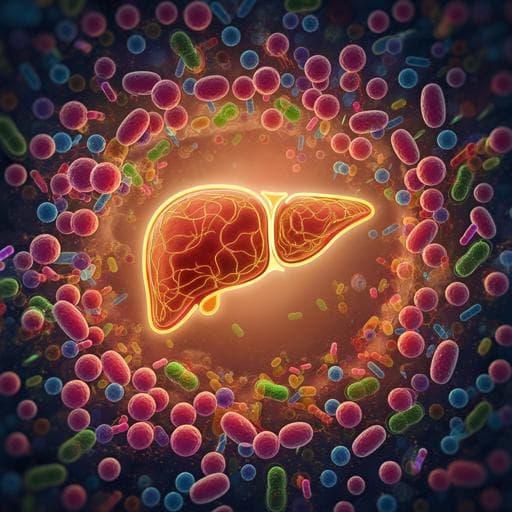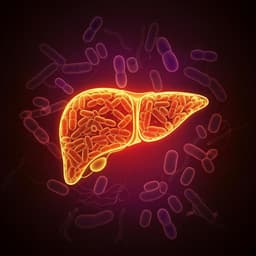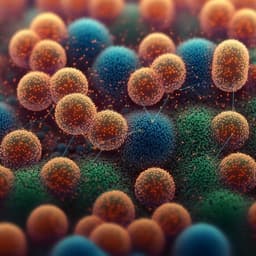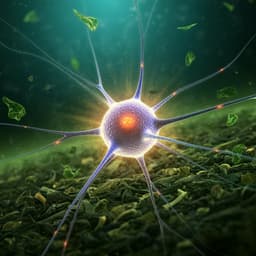
Medicine and Health
Stigmasterol attenuates hepatic steatosis in rats by strengthening the intestinal barrier and improving bile acid metabolism
Y. Zhang, Y. Gu, et al.
Discover how stigmasterol (ST) acts as a powerful ally against high-fat diet-induced dyslipidemia! This groundbreaking research by Yaxin Zhang and colleagues reveals ST's remarkable ability to improve lipid and bile acid metabolism while promoting gut microbiota health. Dive into the nuances of enterohepatic circulation and explore the potential of gut microbiota as a target for treatment.
~3 min • Beginner • English
Introduction
Hyperlipidemia, a major risk factor for cardiovascular disease, is closely linked to hepatic synthesis and enterohepatic circulation of bile acids (BAs). Because accumulation of blood and hepatic lipids drives hyperlipidemia, targeting cholesterol and BA metabolism is a principal therapeutic strategy. BA synthesis from cholesterol proceeds via the classical (neutral) and alternative (acidic) pathways and is tightly regulated by receptors (notably the farnesoid X receptor, FXR/NR1H4), transporters, and metabolic enzymes (e.g., CYP7A1, CYP8B1, CYP27A1, CYP7B1). The gut microbiota modifies hepatic-conjugated primary BAs into secondary BAs (via bile salt hydrolase, 7-dehydroxylation), influencing host metabolism and inflammation. A high-fat diet (HFD) perturbs gut barrier integrity (mucus layer from goblet cells, tight junctions), promoting low-grade inflammation through the gut–liver axis. Phytosterols, structurally similar to cholesterol, reduce intestinal cholesterol absorption and LDL-C, and exhibit immunomodulatory activity. Stigmasterol (ST), a phytosterol, ameliorates fatty liver and metabolic abnormalities in HFD models and improves intestinal inflammation, but its mechanisms in dyslipidemia—particularly via BA metabolism and potential gut barrier/microbiota interactions—remain unclear. The authors hypothesized that ST improves hyperlipidemia by strengthening intestinal barrier function and reprogramming cholesterol/BA metabolism. They profiled serum and fecal BA spectra by LC-MS, assessed hepatic and ileal gene/protein expression involved in BA metabolism, and evaluated the role of gut microbiota using fecal microbiota transplantation (FMT).
Literature Review
Background literature highlights: (1) FXR (NR1H4) is a central regulator of BA homeostasis; chenodeoxycholic acid (CDCA) is a potent FXR ligand. (2) Gut microbiota modulates BA pools via deconjugation and dehydroxylation, thereby impacting host metabolic and inflammatory pathways. (3) HFD impairs intestinal barrier integrity (reduced goblet cells and tight junction proteins), facilitating endotoxin translocation and systemic inflammation via the gut–liver axis. (4) Phytosterols reduce intestinal cholesterol absorption and LDL-C and have immunomodulatory effects; ST has shown benefits in NAFLD/obesity models and may improve gut immune balance via a butyrate–PPARγ axis. These studies provide rationale that ST could modulate BA metabolism (via FXR–CYP7A1 pathways), gut microbiota composition, and intestinal barrier function to ameliorate dyslipidemia and hepatic steatosis.
Methodology
Study design comprised two animal experiments plus FMT and multi-omics/biochemical analyses.
- Animal study I: Forty male SPF Sprague–Dawley rats (8 weeks old) were acclimated, then 32 received high-fat diet (HFD; 45% kcal fat) for 7 weeks; 8 remained on control diet (10% kcal fat). HFD-fed rats were randomized (n=8/group) to 4-week interventions: (1) HFD; (2) HFD + low-dose stigmasterol (STL; 100 mg/kg, intragastric); (3) HFD + high-dose stigmasterol (STH; 200 mg/kg, intragastric); (4) HFD + simvastatin (SIM; 5 mg/kg, intragastric). Body weight recorded weekly.
- Fecal microbiota transplantation (FMT): Donor stools were collected daily in weeks 2–4 of intervention from HFD and STH rats (n=6/group). Recipients (n=6/group) were HFD-fed for 7 weeks, then antibiotic-pretreated (ampicillin, metronidazole, neomycin 0.25 mg/day each; vancomycin 0.125 mg/day; 5 days). Daily intragastric FMT (0.4 mL/100 g) for 4 weeks: HFD donor → H-R; STH donor → ST-R. Body weight weekly; fecal samples stored at −80°C.
- Animal study II (CDCA/ST combination): Eighteen HFD-fed rats (7 weeks HFD) were randomized (n=6/group) to 4-week treatments: (1) HFD; (2) HFD + CDCA (100 mg/kg, intragastric); (3) HFD + CDCA + high-dose ST (CCS; CDCA 100 mg/kg + ST 200 mg/kg, intragastric).
- Sample collection and assays: At endpoint, rats were anesthetized; blood collected from abdominal aorta; serum stored at −80°C. Organs (liver, ileum, epididymal and abdominal fat) weighed and stored. Serum biochemical assays: TC, TG, LDL-C, HDL-C, ALT, AST (kit-based).
- Histology and barrier assessment: Liver, colon, ileum fixed, paraffin-embedded for H&E; frozen sections for Oil Red O (ORO); goblet cells/mucus by Alcian Blue–Periodic Acid-Schiff (AB-PAS). Ileal tight junction proteins (Occludin, ZO-1) assessed by immunohistochemistry (IHC).
- Gut microbiota: 16S rDNA sequencing of fecal samples; alpha diversity (Chao1), beta diversity (PCoA using Bray–Curtis), taxonomic profiles at phylum/family/genus; differential taxa via LEfSe.
- Bile acid (BA) profiling: Serum and fecal BAs extracted (methanol), analyzed by LC–ESI–MS/MS (AB Sciex QTRAP 6500+; Waters ACQUITY UPLC HSS T3 C18 column). Negative ion mode, scheduled MRM; multistep acetonitrile–water gradient with acetic acid/ammonium acetate. Multivariate analysis: PLS-DA; VIP >1 to identify discriminant BAs; heatmaps of top 25 BAs.
- Gene expression: RT–qPCR on liver and ileum for cyp7a1, cyp27a1, cyp7b, cyp8b, nr1h4; normalization to gapdh; 2^-ΔΔCt. Primer sequences provided.
- Protein analyses: Western blot on liver for NR1H4 (FXR), CYP7A1, CYP27A1, ABCG1; densitometry by ImageJ. Immunofluorescence (IF) on liver/ileum for NR1H4, CYP7A1, CYP27A1.
- Statistics: Data mean ± SD; one-way ANOVA with Tukey post hoc; significance at P < 0.05. Ethical approval by Southern Medical University IACUC; SPF housing.
Key Findings
- ST ameliorated HFD-induced obesity and dyslipidemia: HFD increased body weight vs control (P<0.01); daily ST reduced weight gain. ST reduced visceral fat and liver weight. HFD elevated serum TC, TG, LDL-C by 2.04-, 2.03-, 2.40-fold vs control; ST significantly reduced these (P<0.01). HFD increased AST and ALT by 2.22- and 1.49-fold; ST reduced them by 0.62- and 0.58-fold, respectively. Liver histology (H&E, ORO) showed marked steatosis in HFD that improved dose-dependently with ST.
- Intestinal barrier improvements: HFD reduced goblet cells; ST increased goblet cell numbers (AB-PAS). ST increased ileal Occludin and ZO-1 protein expression (IHC).
- Microbiota modulation: ST increased alpha diversity (Chao1). ST shifted community structure (PCoA) and reduced potentially detrimental taxa: Erysipelotrichaceae from 16.71% to 9.77% and Peptostreptococcaceae from 5.47% to 2.03% (P<0.05) vs HFD. Genus Allobaculum was decreased with ST.
- BA metabolome remodeling:
• Serum: PLS-DA separated ST from HFD; TCA had highest VIP and was increased in HFD, decreased with ST. ST increased CDCA; decreased tauro-β-muricholic acid (T-β-MCA) and cholic acid (CA) vs HFD.
• Feces: β-hyocholic acid (β-HCA) increased in HFD, decreased with ST. ST increased HDCA and β-HDCA; decreased CA vs HFD. α-MCA, β-MCA, TLCA, TDCA were lower in control/ST than HFD; DCA, HDCA, β-HDCA higher in control/ST than HFD.
- BA metabolism gene/protein regulation (ST vs HFD): Hepatic and ileal cyp7a1 mRNA upregulated (P<0.01). In liver, HFD reduced nr1h4 and cyp27a1 and increased cyp7b and cyp8b; high-dose ST increased nr1h4 and cyp27a1 (3.64- and 3.83-fold) and decreased cyp7b and cyp8b (0.67- and 0.54-fold) (P<0.05). IF and western blot showed CYP7A1 and CYP27A1 protein down in HFD and up with ST; NR1H4 protein differences were modest; ABCG1 protein decreased in HFD and increased with ST (P<0.05).
- FMT outcomes: Recipients of ST-donor microbiota (ST-R) showed lower visceral fat weight and serum TC than HFD-donor recipients (H-R); HDL-C/TC ratio trended higher. Liver steatosis reduced in ST-R. ST-R had more ileal/colonic goblet cells and higher Occludin/ZO-1. Microbiota alpha diversity (Chao1) increased; Bacteroidetes and Tenericutes increased by 2.16- and 2.85-fold; Erysipelotrichaceae reduced by 0.77-fold vs H-R. LEfSe biomarkers differed (e.g., Bacteroidetes/Christensenellaceae enriched in ST-R). Gene expression: ST-R showed elevated ileal cyp7a1 and reduced hepatic cyp7b (P<0.05). FMT partially reproduced hepatic/intestinal benefits but did not fully recapitulate systemic lipid improvements.
- CDCA + ST combination (CCS) vs CDCA alone: Both reduced visceral and liver weights; CCS further lowered serum TC, TG, LDL-C and increased HDL-C/TC. CCS decreased hepatic vacuolation and increased ileal Occludin/ZO-1. Microbiota shifts: vs CDCA, CCS decreased Proteobacteria (phylum), Ruminococcaceae (family), Allobaculum and Roseburia (genus); increased Lachnospiraceae and Erysipelotrichaceae (family) and Ruminococcaceae_UCG-005/-014. BA-related expression: CCS upregulated hepatic cyp27a1 (3.58-fold), cyp7a1 (1.99-fold), nr1h4 (1.67-fold) and downregulated cyp8b (0.37-fold) vs CDCA; ileal cyp27a1 (1.80-fold) and cyp7a1 (2.08-fold) increased. Western/IF confirmed increased hepatic NR1H4, CYP7A1, CYP27A1.
Overall, ST reduced hepatic lipid accumulation and improved systemic and intestinal metrics by strengthening the intestinal barrier, remodeling gut microbiota, and enhancing cholesterol-to-BA conversion via CYP7A1/CYP27A1 with FXR involvement; CCS amplified these effects.
Discussion
The study demonstrates that stigmasterol mitigates HFD-induced hyperlipidemia and hepatic steatosis primarily through modulation of bile acid metabolism and reinforcement of the intestinal barrier. Upregulation of hepatic and ileal CYP7A1 (rate-limiting for classical BA synthesis) and CYP27A1 suggests enhanced reverse cholesterol transport and increased conversion of cholesterol to primary BAs, notably CDCA, which in turn may activate FXR signaling. Concomitant decreases in TCA and T-β-MCA (an FXR antagonist) further support a favorable FXR milieu. Increased hepatic ABCG1 implies improved cholesterol efflux contributing to lipid lowering.
ST also counteracts HFD-induced gut dysbiosis, reducing Erysipelotrichaceae and Allobaculum, taxa linked to NAFLD and adverse lipid profiles, while increasing overall microbial diversity. Strengthening of the intestinal barrier (more goblet cells; higher Occludin/ZO-1) likely reduces endotoxin translocation and low-grade inflammation, favoring healthier gut–liver axis communication and BA cycling. FMT from ST-treated donors partially reproduced intestinal barrier and some metabolic benefits, underscoring a contributory role of the microbiota, though not fully accounting for all ST effects, indicating additional host-mediated mechanisms.
Combining ST with CDCA (an FXR agonist) further enhanced lipid-lowering, hepatic histology, and BA metabolic gene/protein expression (NR1H4, CYP7A1, CYP27A1) compared to CDCA alone, supporting mechanistic synergy via FXR–CYP7A1 pathways. Collectively, these findings align with the hypothesis that ST improves dyslipidemia through coordinated modulation of BA synthesis/signaling and gut barrier–microbiota dynamics, offering translational relevance for metabolic disease management.
Conclusion
- Stigmasterol attenuates HFD-induced hyperlipidemia and hepatic steatosis, strengthens the intestinal barrier, and beneficially remodels the gut microbiota.
- ST reprograms BA metabolism by upregulating CYP7A1/CYP27A1 (in liver and ileum), increasing CDCA, lowering TCA and T-β-MCA, and enhancing FXR-related signaling; hepatic ABCG1 upregulation suggests improved cholesterol efflux.
- FMT from ST-treated donors partially transfers protective effects on intestinal barrier and hepatic lipid accumulation, implicating microbiota involvement but indicating additional host factors.
- Co-administration of CDCA with ST amplifies metabolic and hepatic benefits and further upregulates FXR–CYP7A1 pathway components.
Future directions: Delineate precise host pathways linking ST to BA metabolism (e.g., FXR/FGF15 axis, transporter networks), identify causal microbial taxa/metabolites mediating benefits, assess dose–response and long-term safety, and validate efficacy in other models and clinical studies.
Limitations
- The study was conducted in rat HFD models; translational generalizability to humans requires validation.
- While FMT indicates a microbiota contribution, it did not fully recapitulate ST’s systemic lipid benefits, suggesting additional host-mediated mechanisms that remain undefined.
- Mechanistic resolution of FXR signaling (e.g., intestinal FXR–FGF15–hepatic CYP7A1 axis), specific transporters, and causal microbial metabolites/taxa was limited.
- Affiliation of some corresponding authors and certain methodological details (e.g., exact BA quantitation values) are not fully specified in the excerpted text.
Related Publications
Explore these studies to deepen your understanding of the subject.







